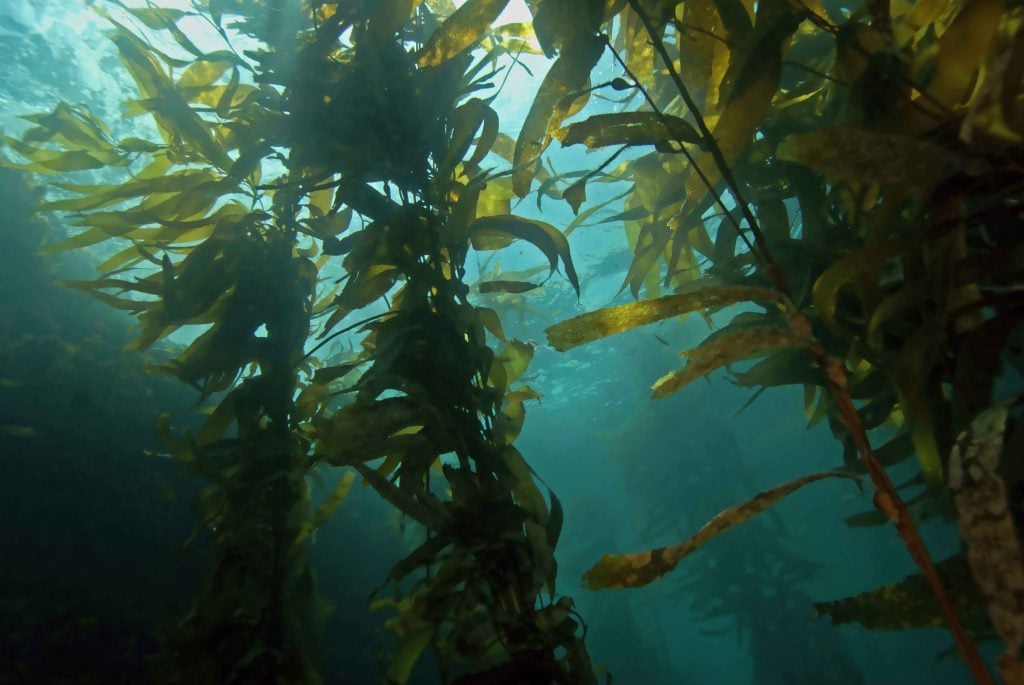
Help the Kelp
What if our redwood forests in Northern California started dying? What if one day we woke up and 93% of our redwoods were gone? We would probably be really freaked out and want to do something about it.
This is the equivalent of what is happening in the ocean, directly off our coast, with the kelp forest. Our Northern California kelp forest has been reduced to an all-time low due to a perfect storm of events over the past five years. The severe reduction in kelp has already impacted the recreational red abalone fishery and commercial red urchin fishery, two economically important fisheries in our region. The kelp forest is also the nursery area for all our commercial rock fish and the bait fish that feed them. It influences our beaches for surf, and shapes the way waves will break. And less visible, but very imperative in this discussion is the fact that kelp is incredibly efficient in sequestering carbon; seaweeds could sequester around 190 million tons of carbon each year, about as much as the annual emissions of the state of New York. We are standing witness to an ecological trophic meltdown, that is not only impacting us locally, but affecting us up and down the West Coast.
HOW DID THIS HAPPEN?
In 2013, Sea Star Wasting Disease, caused by a virus and possibly amplified by warmer ocean temperatures, killed most of our sea stars from Alaska to Mexico. Sea stars are a key predator of purple urchin.
From 2014-2016, our ocean experienced a marine heat wave that began with the “warm water blob” and was followed by El Niño, which created multiple years of warmer ocean temperatures. Kelp are very sensitive to changes in water temperature, and warm water holds few of the nutrients required for vigorous growth. Bull kelp is an annual species that has experienced reduced or negative growth rates due to warm water. We have seen a >93% loss of bull kelp in recent years.
URCHIN BARRENS
Without sea stars to keep their numbers in check, purple sea urchin populations have exploded to more than 60 times their normal densities. Our once lush kelp forests, already struggling from increasing ocean temperatures, are now under attack by “herds” of purple urchin. Grazing primarily on kelp holdfasts and any new growth, purple urchin are preventing bull kelp regrowth. 2016-2017 California Department of Fish and Wildlife surveys have shown:
- Purple urchin barren conditions are increasing.
- Excessive urchin grazing has created >50% bare rock in highest urchin density areas.
- Urchin outcompete red abalone for food; >25% of abalone are shrunken in their shell due to starvation. The abalone fishery is now closed.
As an annual species, bull kelp is reliant on a robust spore bank for re-establishing populations. Four consecutive years of limited spore production may hinder broad-scale recovery of this keystone species.
WHAT IS BEING DONE?
A collaborative team of marine biologists, NGOs, commercial urchin divers, and sport divers have formed to support the recovery of our kelp forests, creating kelp refuges along our coast by clearing urchin from key locations. In this pilot year the HELP THE KELP program will:
- Remove purple urchin from Noyo and Caspar Bays and keep the refuge areas maintained and monitored, documenting kelp regrowth
- Support the development of a market option for purple urchin
- Prioritize refuge sites for 2019
- Explore the ecosystem dynamics between kelp and urchin
- Engage community partners and citizen scientists
- Optimize urchin clearing techniques
- Fundraise
This collaborative research and kelp recovery project will help guide future directions for management of the kelp forest resources.
WHAT YOU CAN DO:
Please donate to HELP THE KELP through our team partner, Noyo Center For Marine Science. For the cost of a $35 abalone dive card, you can help us keep the research boats funded and out on the water, and promote education and awareness about this crisis.
